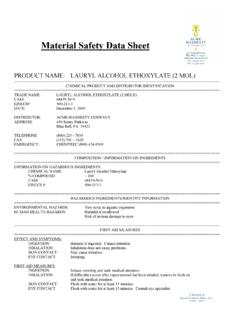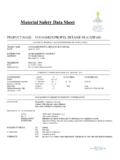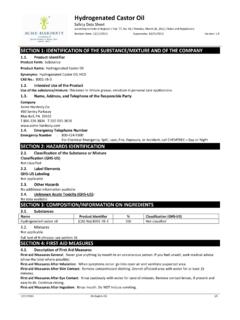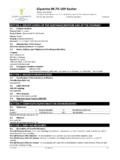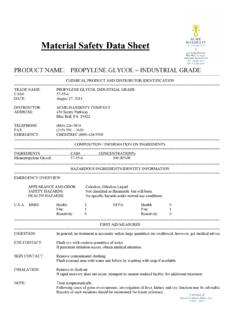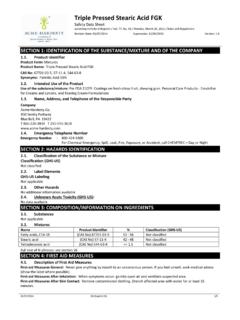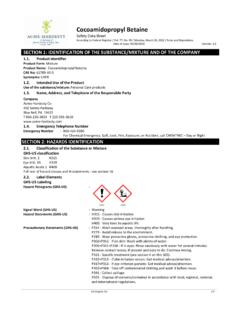Transcription of Material Safety Data Sheet - Acme Hardesty
1 Material Safety Data Sheet PRODUCT NAME: dioctyl sebacate ======================================== ======================================== ============= IDENTIFICATION AND DISTRIBUTOR INFORMATION ======================================== ======================================== ============= TRADE NAME: dioctyl sebacate CAS #: 122-62-3 DATE: May 29, 2008 DISTRIBUTOR: ACME- Hardesty COMPANY ADDRESS: 450 Sentry Parkway Blue Bell, PA 19422 TELEPHONE: (866) 226 3834 FAX: (215) 591 3620 EMERGENCY: CHEMTREC (800) 424-9300 ======================================== ======================================== ============= COMPOSITION / INFORMATION ON INGREDIENTS ======================================== ======================================== ============= INGREDIENT: dioctyl sebacate CHEMICAL NAME: Bis(2-ethylhexyl) sebacate CHEMICAL FAMILY: Ester CHEMICAL FORMULA: C26H50O4 CAS# %WT %VOL SARA 313 REPORTABLE 122-62-3 99% Not reportable PPM mq/m3 OSHA PEL-TWA: Not available OSHA PEL STEL: OSHA PEL CEILING: ACGIH TLV-TWA: Not available ACGIH TLV STEL: ACGIH TLV CEILING: ======================================== ======================================== ============= HAZARDOUS IDENTIFICATION ======================================== ======================================== ============= POTENTIAL HEALTH EFFECTS: EYES: May cause irritation SKIN: May cause irritation INGESTION: -- INHALATION: -- MEDICAL CONDITIONS GENERALLY AGGRAVATED BY EXPOSURE: None reported.
2 May be harmful by inhalation, ingestion, or skin absorption. To the best of our knowledge, the chemical, physical, and toxicological properties have not been thoroughly investigated. Material Safety DATA Sheet dioctyl sebacate May 29, 2008 Page 2 of 5 ======================================== ======================================== ============= ACCIDENTAL RELEASE MEASURES ======================================== ======================================== ============= Absorb with inert Material . Put the spilled Material in an appropriate waste disposal. Keep away from heat and other sources of ignition. Stop leak if without risk. On land, dyke; In water set up a dam and contact appropriate authorities. ======================================== ======================================== ============= FIRST AID MEASURES ======================================== ======================================== ============= EYES: Flush eyes with copious amounts of water for at least 15 minutes, occasionally lifting upper and lower lids.
3 Consult a physician if irritation appears. SKIN: Flush skin with plenty soap and water for at least 15 minutes while removing contaminated clothing and shoes. Contact a physician if irritation persists. INGESTION: Not a likely source of exposure. If swallowed, however, wash out mouth with water provided person is conscious. INHALATION: Remove from exposure to fresh air immediately. If not breathing, give artificial respiration. If breathing is difficult, give oxygen. ======================================== ======================================== ============= FIRE FIGHTING MEASURES ======================================== ======================================== ============= FLASH LIMITS IN AIR (% BY VOLUME): UPPER: Unknown LOWER: Unknown FLASH POINT: F, 227 C (OC) AUTO-IGNITION TEMP: 500 F, 227 C UNUSUAL FIRE / EXPLOSION HAZARDS: -- HMIS CLASSIFICATION: HEALTH: 1 FLAMMABILITY: 1 REACTIVITY: 0 PERSONAL PROTECTION: H NFPA CLASSIFICATION: HEALTH: 1 FLAMMABILITY: 1 REACTIVITY: 0 EXTINGUISHING MEDIA: Use water fog, alcohol resistant foam, dry-chemical, or carbon dioxide SPECIAL PROCEDURES: As in any fire, wear self-contained breathing apparatus in pressure demand.
4 MSHA/NIOSH (approved or equivalent), and full protective gear. During a fire, irritating and highly toxic gases may be generated by thermal decomposition or combustion. HAZARDOUS DECOMPOSITION: As with other organic materials, combustion will produce carbon monoxide and carbon dioxide. Material Safety DATA Sheet dioctyl sebacate May 29, 2008 Page 3 of 5 ======================================== ======================================== ============= HANDLING & STORAGE ======================================== ======================================== ============= Avoid contact with eyes, skin and clothing. Wash thoroughly after handling. Remove contaminated clothing and wash before reuse. Avoid eye contact and inhalation. Use with adequate ventilation. Store in cool, dry place. Keep container closed when not in use. ======================================== ======================================== ============= EXPOSURE CONTROLS / PERSONAL PROTECTION ======================================== ======================================== ============= ENGINEERING CONTROLS: Ventilation is recommended in order to maintain vapor concentration below permitted limits.
5 Make sure an emergency eye wash and a shower can be found at the work place. VENTILATION: Mechanical ventilation is recommended. RESPIRATORY PROTECTION: Use MSHA/NIOSH respirator. EYE PROTECTION: Wear chemical goggles. SKIN PROTECTION: Wear compatible chemical resistant gloves and sufficient clothing to minimize physical contact. HYGIENIC PRACTICES: During application, adequate ventilation must be approved. ======================================== ======================================== ============= PHYSICAL/CHEMICAL CHARACTERISTICS ======================================== ======================================== ============= APPEARANCE: ABOVE ROOM TEMP: clear oily liquid BELOW ROOM TEMP: crystalline solid ODOR: Mild pH: N/AAvailable BOILING POINT, C: 255 @ 20 mm Hg FREEZING/MELT POINT: -- VAPOR PRESSURE @ 210 C: VAPOR DENSITY (AIR=1): SPECIFIC GRAVITY (water=1): EVAPORATION RATE: Negligible SOLUBILITY IN WATER: MOLECULAR WT: VISCOSITY@ 40 C: ======================================== ======================================== ============= STABILITY & REACTIVITY ======================================== ======================================== ============= STABILITY.
6 Stable under normal conditions CONDITIONS TO AVOID: None reported. INCOMPATIBILITY: Strong oxidizing agents HAZARDOUS DECOMPOSITION: Irritating and toxic fumes and gases. Combustion will produce carbon monoxide and carbon dioxide. HAZARDOUS POLYMERIZATION: Will not occur CONDITIONS TO AVOID: N/A ======================================== ======================================== ============= Material Safety DATA Sheet dioctyl sebacate May 29, 2008 Page 4 of 5 TOXICOLOGICAL INFORMATION ======================================== ======================================== ============= IVN-RAT LD50: 900 mg/kg MRLR**#256, 1954 ORL:MUS LD50: 9500 mg/kg 85 GMAT-62, 1982 IVN-RBT LD50: 540 mg/kg MRLR**#256, 1954 Only selected registry of toxic effects of chemical substances (RTECS) data is presented here. See actual entry in RTECS for complete information.
7 ======================================== ======================================== ============= ECOLOGICAL INFORMATION ======================================== ======================================== ============= This substance has some potential to biodegrade with acclimated microorganism form activated sludge. It has a low potential to persist in the environment, and a low potential to bioconcentrate. This substance floats on water, however, an accidental spill in water is not expected to affect the environment because it rapidly dilutes to PRODUCTS OF BIODEGRADATION: carbon dioxide and water. The BDO5 has not been determined but it is surely very low. ======================================== ======================================== ============= DISPOSAL CONSIDERATIONS ======================================== ======================================== ============= WASTE DISPOSAL METHOD: Dispose of in accordance with all applicable local, state, and federal guidelines.
8 Container labels should not be removed until they have been cleaned. Contaminated containers should not be treated as household waste. Containers should be cleaned by appropriate methods and then re-used or disposed of by landfill or incineration as appropriate. RCRA HAZARD CLASS: None listed ======================================== ======================================== ============= TRANSPORT INFORMATION ======================================== ======================================== ============= DEPARTMENT OF TRANSPORTATION PROPER SHIPPING NAME: Synthetic Plastic Plasticizer HAZARD CLASS: Not applicable ID NUMBER: Not applicable PACKING GROUP: Not applicable LABEL STATEMENT: Not applicable WATER TRANSPORTATION PROPER SHIPPING NAME: No information available; Not listed as a Hazardous Material HAZARD CLASS: Not applicable ID NUMBER: Not applicable PACKING GROUP: Not applicable LABEL STATEMENTS: Not applicable AIR TRANSPORTATION PROPER SHIPPING NAME: No information available.
9 Not listed as a Hazardous Material HAZARD CLASS: Not applicable ID NUMBER: Not applicable PACKING GROUP: Not applicable LABEL STATEMENT: Not applicable Material Safety DATA Sheet dioctyl sebacate May 29, 2008 Page 5 of 5 ======================================== ======================================== ============= REGULATORY INFORMATION ======================================== ======================================== ============= FEDERAL REGULATIONS: TSCA (TOXIC SUBSTANCE CONTROL ACT): CAS# 122-62-3: Listed CERCLA (COMPREHENSIVE RESPONSE COMPENSATION, AND LIABILITY ACT): Not available SARA TITLE III (SUPERFUND AMENDMENTS AND REAUTHORIZATION ACT): RQ=0, TPQ=0 311/312 HAZARD CATEGORIES: Not listed. 313 REPORTABLE INGREDIENTS: Not listed. CLEAN AIR ACT: This Material does not contain any hazardous air pollutants.
10 This Material does not contain any Class 1 Ozone depletors. This Material does not contain any Class 2 Ozone depletors. CLEAN WATER ACT: None of the chemicals in this product are listed as Hazardous Substances under the CWA. None of the chemicals in this product are listed as Priority Pollutants and the CWA. None of the chemicals in this product are listed as Toxic Pollutants under the CWA. OSHA: None of the chemicals in this product are considered highly hazardous by OSHA. STATE REGULATIONS: -- EUROPEAN/INTERNATIONAL REGULATIONS: HAZARD SYMBOLS: Not available RISK PHRASES: --- Safety PHRASES: S24/25 Avoid contact with skin and eyes. INVENTORY STATUS: DSL/NDSL: Listed: Supplement to Canada Gazette, Part I, January 26, 1991 EINECS: Listed (204-558-8): Annex to Official Journal of the European Communities, 15 June 1990 ENCS: Unlisted chemical name.
